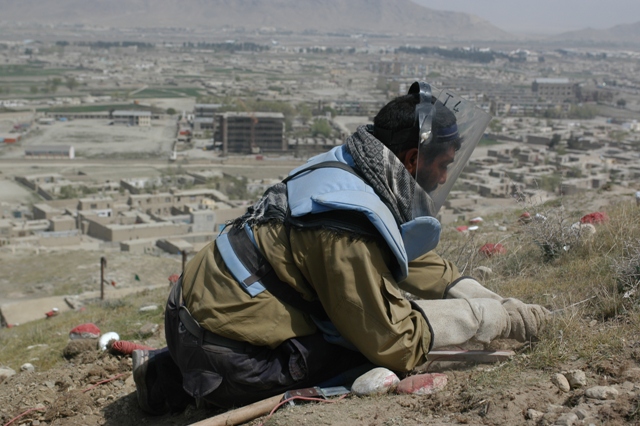Disarm

Uprooting Violence
Disarm
Directed by Mary Wareham and Brian Liu
Next Step Productions/Toolbox P.C.
Available on DVD from www.Indiepixfilms.com
When peace comes, there are going to be massive casualties,” says Yeshua Moser-Pangsuwan of Nonviolence International, speaking from the troubled border between Thailand and Myanmar.
So many landmines contaminate the border area, he explains, that residents of local refugee camps stay inside the camps for safety. But if and when the fighting ends and the refugees try to return to their homes, mines will kill many en route.
Such deaths are the message of Disarm, the wrenching account of the heroic campaign to ban the use of a single weapon—the anti-personnel landmine—and to bring to an end the devastation it has caused and continues to cause around the world.
The landmine campaign is now observing the tenth anniversary of the moment that the 1997 Ottawa Convention banning landmines became international law. Released this March on DVD to celebrate that anniversary, Disarm tells the story of the next stages of the campaign, primarily the efforts to destroy the stockpiles of landmines, help victims, and, most urgently, remove from the ground the millions of landmines that have been planted in war-torn countries around the world, mines that still claim as many as 15,000 to 20,000 victims a year.
The tone is set early, with a hard-to-watch sequence of the rescue of a badly injured youth somewhere along the Thailand-Myanmar border, where cameras are illegal and rescue workers were risking arrest by videoing the event at all. But that risk pales in comparison with the risk that they—and all who work in this dangerous field—face every day, the risk of dismemberment or death from the very weapons they’re there to neutralize.
Disarm brings audiences face to face with many such workers—and many landmine victims. Deminers in Afghanistan and Bosnia and Herzegovina comb the ground carefully. An Afghanistan medical worker says that so many mines remain in the ground in that battered land, continuing to kill and maim, that the “factory of the legs”—manufacturing artificial limbs—is Afghanistan’s biggest industry. An officer in the Belarus army proudly shows off his country’s carefully orchestrated campaign to destroy its landmine stockpile—“our unwanted heritage from the Soviet Union.” A beautiful 12-year-old Colombian girl talks about the “accident” that blew off her leg when she was nine.
Disarm was a first film for its directors, anti-landmine activist Mary Wareham and photojournalist and designer Brian Liu, and their inexperience is visible in the somewhat rambling and not very shapely documentary. But their passion—and the material—will sear Disarm into the memory of everyone who sees it and convince many viewers that they must join the fight to rid the world of this terrible weapon.
That goal will be a little closer when four world powers that have so far refused to sign the landmine treaty are persuaded to do so. Some 170 countries are now signatories, and the International Campaign to Ban Landmines and campaign leader Jody Williams of the United States received the Nobel Peace Prize in 1997. Not yet among the signers are the Russian Federation, China, India—and the United States.
